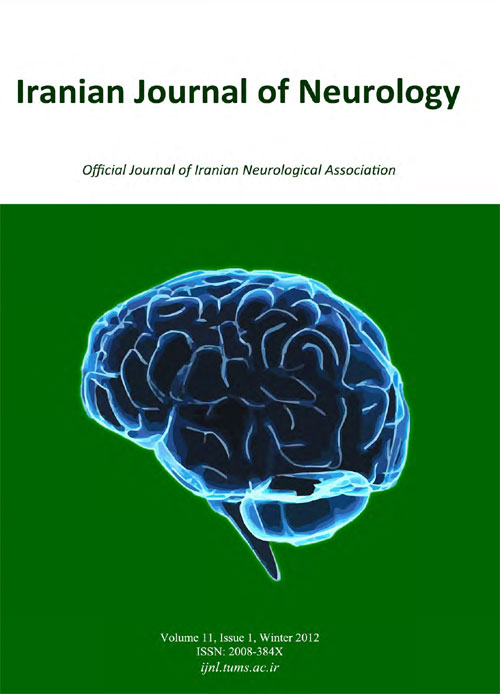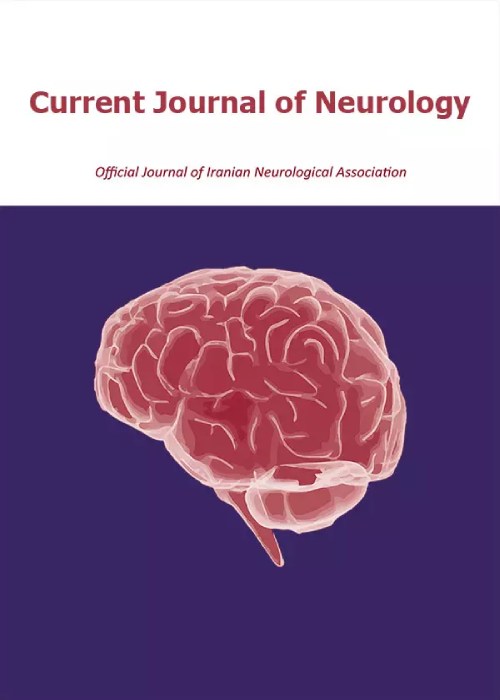فهرست مطالب

Current Journal of Neurology
Volume:11 Issue: 1, Winter 2012
- تاریخ انتشار: 1391/03/16
- تعداد عناوین: 10
-
-
Page 0
-
Pages 1-5BackgroundImpact of high level of uric acid on stroke is still controversial. We conducted this study to investigate the relationship between acute ischemic non-embolic stroke and serum levels of uric acid.MethodsThis was a case-control study on patients with acute ischemic non-embolic stroke in Rafsanjan, Iran. The control group consisted of normal persons who were similar to the case group in terms of age and gender. Serum level of uric acid in the first 24 hours of admission was measured with photometry method.ResultsIn a total of 130 patients (59 mens), hyperuricemia was seen in 13.0% of subjects in the control group and 10.7% of subjects in the case group. Nine patients in case group and 7 patients in control group with hyperuricemia were women. No significant relationship was found between acute ischemic non-embolic stroke and serum level of uric acid.ConclusionThere was no relationship between uric acid and acute ischemic non-embolic stroke.Keywords: Ischemic Stroke, Uric Acid, Risk Factor
-
Pages 6-11BackgroundMultiple sclerosis (MS), a chronic inflammatory demyelinating disorder with neurodegenerative aspects, is more common among young adults, particularly women.MethodsThis molecular study was designed to investigate the IL-7R α chain gene in Iranian MS patients. We studied 60 MS patients, diagnosed based on 2005 R-McDonald criteria and 60 apparently healthy individuals as the control group. DNA was extracted from whole blood cells using MBST/IRAN Extraction kit and all samples were screened for possible sequence variation in three regions including promoter, exon 2 and exon 4 with single strand conformation polymorphism (SSCP).ResultsThe alterations were confirmed with direct sequencing by ABI 3730XL. Although no mutation was detected in the studied regions, eight single nucleotide polymorphisms (SNPs) consisting of rs71617734 in promoter; rs35967524, rs11567704, rs1494558, rs11567705 and rs969128 in exon 2 as well as rs1494555 and rs2228141 in exon 4 were observed. The rs1494558 in exon 2 and rs1494555 in exon 4 were missense variations. Our results also showed the substitution of isoleucine with threonine in rs1494558 (P.I66T) with this accession number, FR863587 submitted in EMBL bank. The study of exon4 areas revealed two SNPs and two sequence variations, where [p.V138I] Valine substituted with isoleucine (FR863588), as well as a silent nucleotide substitution [P. H165H] in the absence of amino acid alteration. The analysis of the SNP genotype in the controls and the patients, using χ2 showed no significant association with multiple sclerosis in this group.ConclusionOur study demonstrated the effects of some SNPs on the IL-7R α protein in MS. Further studies are required to reveal the effects of these SNPs on the IL- 7R α protein in multiple sclerosis.Keywords: IL, 7R 9, Polymorphism, SNPs, SSCP, Sequencing, Multiple Sclerosis
-
Pages 12-15BackgroundOptical coherence tomography (OCT) is a non-invasive instrument, which can be used to estimate the thickness of the retinal nerve fibre layer (RNFL) and provides an indirect measurement of axonal destruction in multiple sclerosis (MS). The main aim of this study was to find out any correlations between P100 latency in visual evoked potential (VEP) and RNFL thickness.MethodsThe patients with the definite history of optic neuritis regardless of the diagnosis of MS were included. The eyes with the history of blurred vision and increased VEP latency (> 115 milliseconds) were considered as cases and the eyes with normal latency were regarded as controls. RNFL thickness was compared between two groups of cases and controls. In addition, the correlation between VEP P100 latency and RNFL thickness in four quadrants of superior, nasal, inferior and temporal fields was estimated by spearman correlation coefficient. RNFL thickness between the patients with history of clinically isolated syndrome (CIS) was also compared to other two subgroups of RRMS and SPMS.ResultsThere was significant negative correlation between VEP P100 latency and RNFL. In all four quadrants, with increasing VEP latency, RNFL thickness decreased. Furthermore, there was significant correlation between P100 latencies and mean RNFL thickness [Pearson correlation coefficient = -0.527, P < 0.001; RNFL (mean) = (-0.44 ± 0.087) × P100 + (153.6 ± 10.94)]. Comparing RNFL thickness between three groups of CIS, RRMS, and SPSM, no significant difference was detected in RNFL thickness (P > 0.05). Power analysis demonstrated that RNFL average had the highest area under curve.ConclusionOCT does have good correlations with P100 latency, indicating retinal non-myelinated axonal involvement in early stages in addition to the myelinated axonal involvement. However, it cannot be used as the sole test in evaluating visual pathway in optic neuritis and complementary tests as VEPs are recommended.Keywords: Optical Coherence Tomography, Multiple Sclerosis, Clinically Isolates Syndrome, Visual Evoked Potential
-
Pages 16-20BackgroundThe most common neurologic manifestation of gluten sensitivity is ataxia, which accounts for up to 40% of idiopathic sporadic ataxia. Timing of diagnosis of gluten ataxia is vital as it is one of the very few treatable causes of sporadic ataxia and causes irreversible loss of Purkinje cells. Antigliadin antibody (AGA) of the IgG type is the best marker for neurological manifestations of gluten sensitivity. This study was conducted to measure the prevalence of gluten ataxia in a group of Iranian patients with idiopathic ataxia.MethodsFor 30 patients with idiopathic cerebellar ataxia, a questionnaire about clinical and demographic data was completed. Serum AGA (IgA and IgG) and antiendomysial antibody (AEA) were assessed. Gluten ataxic patients underwent duodenal biopsy. Magnetic resonance imaging was done for all patients to see if cerebellar atrophy is present.ResultsOnly 2 patients had a positive IgG AGA (6.7%) who both had a positive AEA while none of them showed changes of celiac disease in their duodenal biopsies. Only presence of gastrointestinal symptoms and pursuit eye movement disorders were higher in patients with gluten ataxia.ConclusionPrevalence of gluten ataxia in Iranian patients with idiopathic ataxia seems to be lower than most of other regions. This could be explained by small sample size, differences in genetics and nutritional habits and also effect of serologic tests in clinical versus research setting. Further researches with larger sample size are recommended.Keywords: Celiac Disease, Idiopathic Ataxia, Gluten Ataxia, Prevalence
-
Pages 21-24BackgroundOmega-3 polyunsaturated fatty acids (PUFA) have beneficial effects on both specific and non-specific inflammatory reactions. The aim of this study was to evaluate the effect of dietary supplementation with fish oil in migraine prevention.MethodsA 12-week, randomized, single-blind clinical trial was conducted from October 2008 to June 2009. A total of 67 patients (52 women, 15 men) with migraine headache were randomly allocated to 2 groups. In the first group, 38 patients (30 females with a mean age of 35 ± 9 year) received 400 mg/day sodium valproate. In the second group, 29 patients (22 females with a mean age of 36 ± 9 years) received sodium valproate 400 mg daily plus fish oil supplementation (180 mg). Response to the treatment was assessed at 0, 1, 2, and 3 months after start of the therapy.ResultsA significant decrease in duration, monthly frequency, and severity of headache after month 1, 2, and 3 in comparison with month 0 occurred in both groups. There was a significant reduction in headache severity (P = 0.046) and frequency (P = 0.044) in the group with fish oil supplementation after month 1 in comparison with sodium valproate alone. In contrast, there was no significant difference between two treatment groups in duration of the headache after month 1. Mean intensity, mean duration and mean frequency of the attacks after month 2 and 3 were not significantly different between the two groups.ConclusionThis study demonstrated that sodium valproate plus fish oil supplementation significantly reduces migraine headache more than sodium valproate alone but only at the beginning of the treatment.Keywords: Fish Oil, Migraine, Sodium Valproate, Pain
-
Pages 25-27Amyotrophic lateral sclerosis (ALS), the most common form of motor neuron disease, is a progressive and devastating disease involving both lower and upper motor neurons, typically following a relentless progression towards death. Therefore, all efforts must be made by the clinician to exclude alternative and more treatable entities. ALS with laboratory abnormalities of uncertain significance is a subgroup of ALS that occurs in association with laboratory defined abnormalities that are of uncertain significance to the pathogenesis of ALS. The clinical utility of these abnormalities and what they ultimately mean in patients with ALS is discussed here, along with a review of the literature.Keywords: Amyotrophic Lateral Sclerosis, Motor Neuron Disease, Laboratory Abnormality
-
Pages 28-29Facioscapulohumeral muscular dystrophy (FSHD) is a common inherited muscular dystrophy presented clinically with slowly progressive weakness and wasting of facial and limb muscles and rare bulbar muscle involvement. We present herein a 70-year-old man who was a known case of FSHD with complaint of 15-day history of progressive difficulty in chewing and dysarthria and was found to have myasthenia gravis. Related literatures have been also reviewed.Keywords: Facioscapulohumeralmuscular Dystrophy, Myasthenia Gravis, Myopathy, Iran
-
Pages 30-33Medulloblastoma is one of the most common primary tumors of the central nervous system of children but it is uncommon in adult age. We report a case of young male presented with a history of generalized headache that was found to have medulloblastoma with diffuse leptomeningeal involvement without prominent mass lesion. To our knowledge, our patient is the second reported case of medulloblastoma in adults identified with primary leptomeningeal involvement without a prominent mass lesion. The clinical, radiological and pathologic features of this entity are described.Keywords: Medulloblastoma, Children, Headache, Leptomeningeal Metastasis


